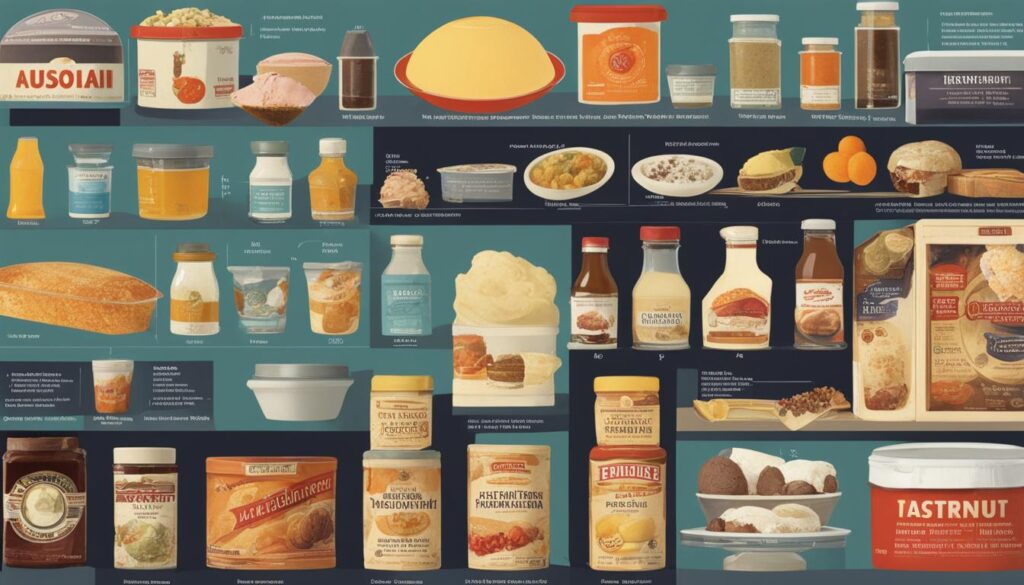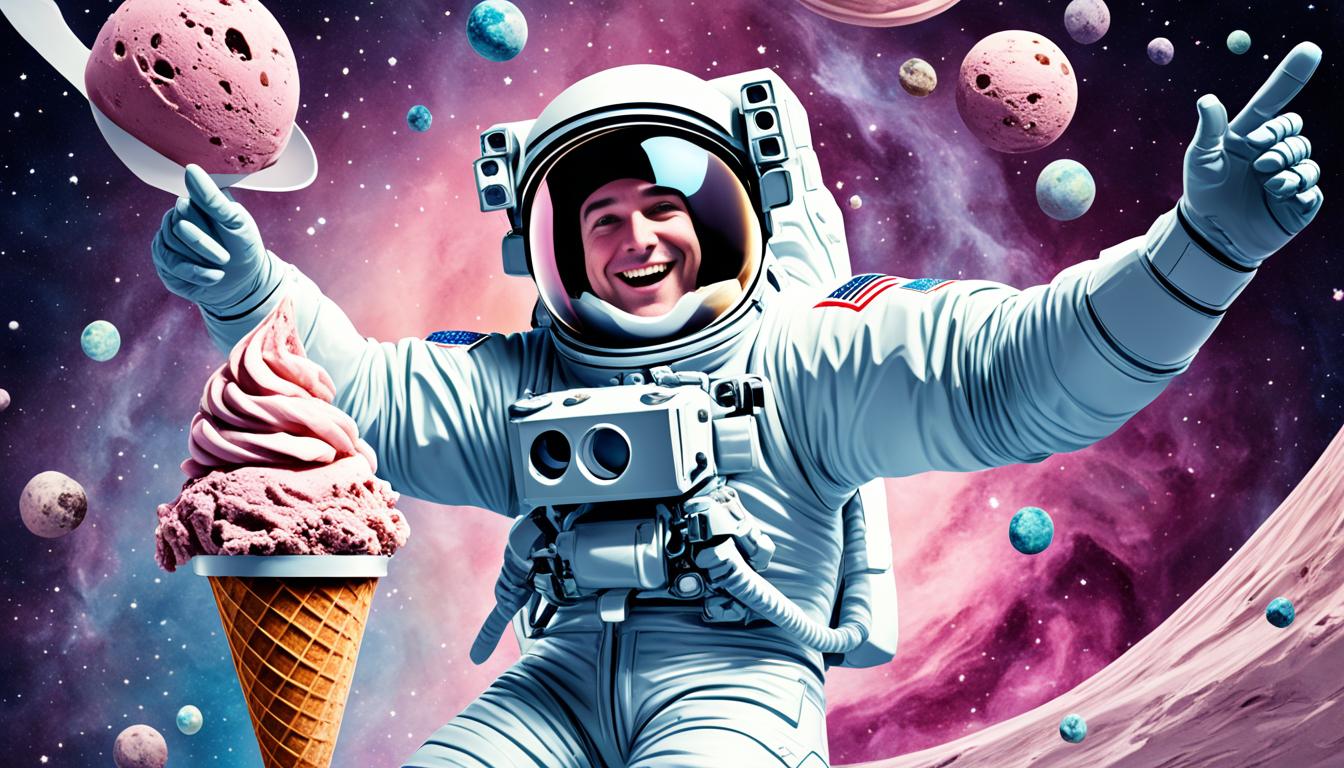Have you ever wondered what astronauts eat in space? The answer might surprise you. It’s not just freeze-dried meals and space-age technology. There’s a particular treat that has captured the imaginations of space enthusiasts for decades. It’s called astronaut ice cream, and its history is as fascinating as it is delicious.
Before we delve into the origins and evolution of this beloved freeze-dried dessert, let’s take a moment to reflect on our childhood dreams of exploring outer space. Remember the awe-inspiring stories of astronauts embarking on daring missions to the moon? If you ever wondered what they ate amongst the stars, keep reading.
Key Takeaways:
- Astronaut ice cream was freeze-dried and served during the Apollo 7 mission in 1968, but it was not a popular choice among astronauts.
- Real ice cream made its way into space on Space Shuttle Atlantis in 2006, and in 2012, ISS crew members were treated to Blue Bell ice cream.
- Freeze-dried ice cream was initially developed to solve the challenge of storing food in space without refrigeration.
- Astronaut ice cream gained popularity as a novelty treat on Earth, despite its limited presence in actual space missions.
- Today, astronaut ice cream continues to be produced and enjoyed, allowing people to experience a taste of space at home.
The Evolution of Astronaut Desserts
In the early days of space exploration, NASA faced the challenge of providing astronauts with food that could be consumed in a zero-gravity environment. One of their initial concerns was whether food digestion was possible without the aid of gravity. To address this issue, NASA collaborated with the Whirlpool Corporation to develop innovative solutions for storing and consuming food in space.
The Birth of Freeze-Dried Astronaut Ice Cream
As part of their quest to find space-friendly food options, NASA introduced freeze-dried astronaut ice cream. This unique treat was created by freeze-drying regular ice cream, which involved removing the water content while maintaining the flavor and nutrients. The result was a lightweight, shelf-stable dessert that could be rehydrated in space. Although freeze-dried ice cream became synonymous with astronaut desserts, its popularity among actual astronauts was limited.
Over time, NASA expanded the menu of astronaut treats, offering a diverse range of options to cater to the preferences of the space explorers. These options included bacon cubes, fruit drinks, shrimp cocktails, tortillas, and even pizza. By continuously innovating and experimenting with various food items, NASA ensured that astronauts had a wide array of delicious options to enjoy during their missions.
“The evolution of astronaut desserts showcases NASA’s commitment to providing astronauts with nutritious and enjoyable food options in the unique environment of space.”
The NASA Astronaut Treats Menu
| Astronaut Desserts | Description |
|---|---|
| Freeze-dried Astronaut Ice Cream | A lightweight, shelf-stable dessert that can be rehydrated in space. |
| Bacon Cubes | Crunchy, bite-sized cubes of bacon, providing a savory treat for astronauts. |
| Fruit Drinks | Nutrient-rich fruit drinks to keep astronauts hydrated and refreshed. |
| Shrimp Cocktails | Ready-to-eat shrimp cocktails, offering a taste of seafood in space. |
| Tortillas | Soft and flexible tortillas, serving as a versatile base for various meal options. |
| Pizza | Astronaut-friendly pizza with a specially-designed crust and toppings. |
This diverse menu of NASA astronaut treats exemplifies the continuous evolution of space food, ensuring that astronauts have a variety of appetizing options to choose from while experiencing the wonders of space.
The Origins of Freeze-Dried Ice Cream
Freeze-dried ice cream has a fascinating history that can be traced back to its origins as a solution for storing food in space. When regular ice cream melts, the air trapped inside escapes, making it challenging to package and preserve. To overcome this obstacle, Whirlpool engineers devised a method to remove the water from ice cream without melting it, giving birth to freeze-dried ice cream.
To create freeze-dried ice cream, the process begins by cooling the ice cream to below -15°C. This temperature ensures that the ice cream retains its structure while becoming firm enough for the next step. Next, a vacuum pump is utilized to evaporate the ice directly from the frozen state, bypassing the liquid phase. The result is a lightweight, crunchy, and freeze-dried ice cream that can be stored at room temperature and rehydrated when needed.
This innovative method of freeze-drying ice cream revolutionized space food technology by providing astronauts with a lightweight and long-lasting treat that could withstand the rigors of space travel. It solved the challenge of preserving perishable foods and allowed for the inclusion of ice cream in the astronauts’ menu.
“The process of freeze-drying ice cream was a breakthrough in space food technology. It allowed us to enjoy a delicious frozen treat even in zero gravity, adding a sense of comfort and familiarity to our space missions.” – Astronaut Michael Collins
The Popularity of Astronaut Ice Cream
Despite its limited presence in actual space missions, astronaut ice cream has gained significant popularity as a novelty treat on Earth. Its unique texture and association with space exploration have made it a hit among space enthusiasts, museum-goers, and candy lovers alike.
Astronaut ice cream is often sold in space-themed packaging, capturing the imagination of those interested in the wonders of outer space. You can find it in museums, toy shops, amusement parks, and outdoor stores, serving as a symbol of space exploration and a cherished souvenir for many.
This freeze-dried delight fascinates people with its peculiar texture and the idea of enjoying a snack that astronauts may eat while embarking on space missions. Its popularity transcends age groups, as both children and adults are captivated by the idea of space-themed treats.
So, next time you visit a museum or embark on a space-themed adventure, don’t forget to indulge in some astronaut ice cream. It’s a tasty way to explore the wonders of space missions and satisfy your cravings for cosmic confections.
For a visual treat, take a look at this image of astronaut ice cream:
Present-Day Availability of Astronaut Ice Cream
While astronaut ice cream may not be a staple on space stations, it continues to be produced and enjoyed on Earth.
Companies like Astronaut Ice Cream offer a variety of freeze-dried ice cream flavors, including new additions like Cookies & Cream and Mint Chocolate Chip. These freeze-dried treats have a long shelf life and are made from 100% real ice cream.
They can be purchased individually or in bundled packs, allowing people to experience a taste of space at home.

| Flavor | Description |
|---|---|
| Vanilla | Classic vanilla flavor for a nostalgic treat |
| Chocolate | Rich and indulgent chocolate flavor |
| Strawberry | Sweet and fruity strawberry taste |
| Cookies & Cream | Crunchy chocolate cookie pieces mixed with creamy ice cream |
| Mint Chocolate Chip | Cool and refreshing mint flavor with chocolate chips |
Conclusion
The history of astronaut ice cream showcases the incredible ingenuity and innovation behind space food technology. While it may not have been widely embraced by astronauts during their missions, astronaut ice cream has become an iconic symbol of space exploration here on Earth.
Freeze-dried ice cream continues to captivate the imaginations of people of all ages, offering a unique opportunity to experience a taste of what astronauts might enjoy while orbiting the Earth. Whether cherished for its novelty or its connection to the wonders of space, astronaut ice cream has undeniably made a lasting impact in both the realms of food and space exploration.
As we indulge in this popular freeze-dried treat, we can’t help but appreciate the remarkable advancements in food preservation and packaging that have made it possible. The journey of freeze-dried ice cream began with a solution to the challenge of preserving food in space and has evolved into a beloved sensation enjoyed by millions around the world. It serves as a reminder of the incredible strides we have made in turning the impossible into reality.
